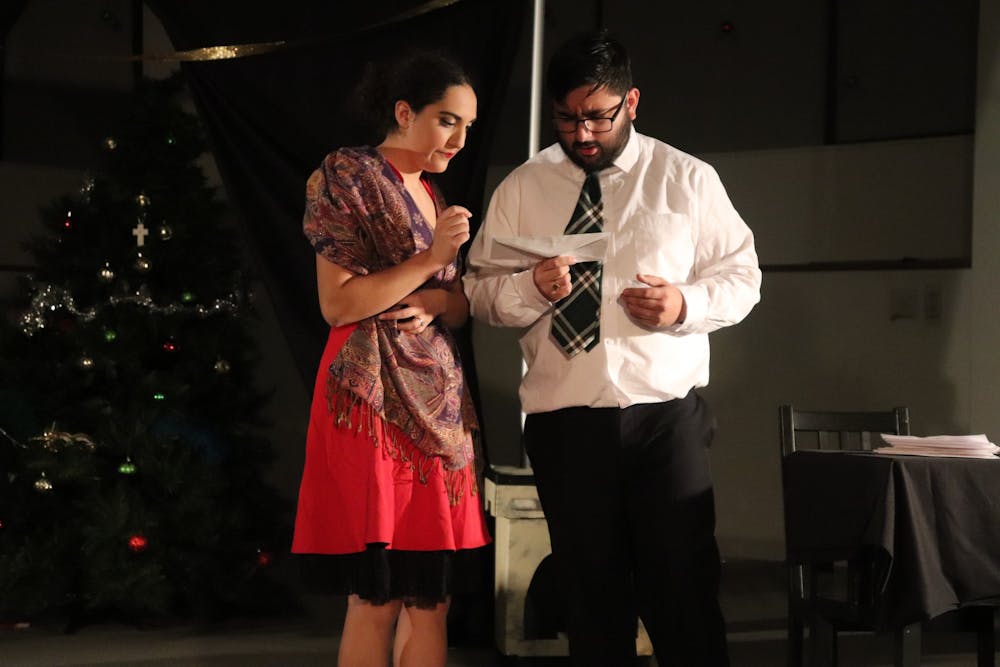AU Rude Mechanicals presented their last show of the semester, “A Doll’s House,” directed by Valarie McFatter, on Nov. 22 and 23.
“A Doll’s House” explores the duality of domesticity. The audience is shown the external struggles of Nora Helmer (Maggie Rocha), a woman who is attempting to balance being a wife and a mother while keeping a secret from her husband. We also see her internal struggles as she tries to discover what it means to be an individual outside of her gendered expectations. Nora’s demeaning and patriarchal husband, Torvald (Abhay Dewan), treats her as if she is a toy he can mold and bend to his needs.
In the AU Rude Mechanicals version, the cast and crew swayed from the original script, in both thought-provoking and successful ways. The original play by Norwegian playwright Henrik Ibsen is three acts long and set in late 19th-century Norway. The AU Rude Mechanicals’ show was condensed into one act (running approximately an hour and a half) and was set in mid-20th-century America.
Beyond altering the setting and act length, the show introduced an omnipresent character: a child version of Nora. The show opened with the stage drenched in a light blue tint and a child (Mary Luz Tagorda) running down the center aisle towards the back of the stage. The child climbs onto a table and then onto a ledge that is home to baby dolls and other children’s toys. The other characters pause before entering the scene, making the audience wonder who that child is.
As the show progresses, the child watches over the different scenes, only removing herself from her perch when Nora interacts with her children. The stage becomes tinted red, an old record begins to play and with the snap of her finger, the child begins to control each of the characters in the scene.
Throughout the show, this dream-like sequence occurs a few times. While the audience can infer that the character is representative of Nora as a child, this image is not made clear until Nora and Torvald’s final fight where adult Nora stands up for her independence. The child lingers in the background, watching with scared expressions as her adult self decides to leave her abusive husband.
While Ibsen originally wrote two endings for the play — one with Nora leaving her family and one with her staying — the AU Rude Mechanicals chose a different variation. Once Nora confidently strides down the center aisle after melting Torvald’s wedding band and leaving her husband and children behind, the child dismounts from her ledge, stares into the fireplace and shouts at Torvald. All the other characters enter onto the stage and join in the chant as they tip over furniture and finally encircle him. Their chanting disrupted the domestic sphere, implying that those with the most power in society need to be held more accountable for their toxic behaviors.
Each of the characters stood out at different points for their emotions and delivery. Dewan’s portrayal of Torvald created a patronizing and unsettling tone. Alexandra Plummer, playing Mrs. Linde, and Dan Sanclemente, playing Krogstad, both stood firm in their supporting roles, shining their brightest in a scene together where Mrs. Linde admits her love for him again.
In a play where there is an intense focus on performative behaviors, Rocha’s portrayal of Nora made the show what it was. She believably performed her role as an obedient woman by exaggerating the sweetness of her tone to show all the other characters her alleged love for domesticity. Rocha did not stop there. She was able to turn off her stereotypical demeanor and transition into Nora’s internal thoughts about leaving her family and the idea of death. Rocha’s anguish and anxiousness grew more intense with every scene, and her ability to seamlessly move between Nora’s two sides made this version of “A Doll’s House” both chilling and exceptional.
Overall, the AU Rude Mechanicals’ modernization of Henrik Ibsen’s “A Doll’s House” begs the question: how much has changed over the centuries for marginalized groups, including, but not limited to, women?
As audience members reflect on this question, Valarie McFatter’s director’s note within the program described the essence of the show with eloquence: “To all who aren’t taken seriously, to all who are told they should try to calm down, to all the Nora’s: you can break away and make the world your own.”
smirah@theeagleonline.com





